How many solar panels do I need?
Are solar panels worth it? As of June 2024, 5% of UK homes are powered by solar panels. In fact, that’s around 1.4 million homes! This is an astounding jump from 3.5% just two years ago and it shows us how more people are turning to solar to reduce their electricity bills and reduce their carbon footprint. But before homeowners make the switch, many have questions, and one of the first questions homeowners ask is: “How many solar panels do I need?”
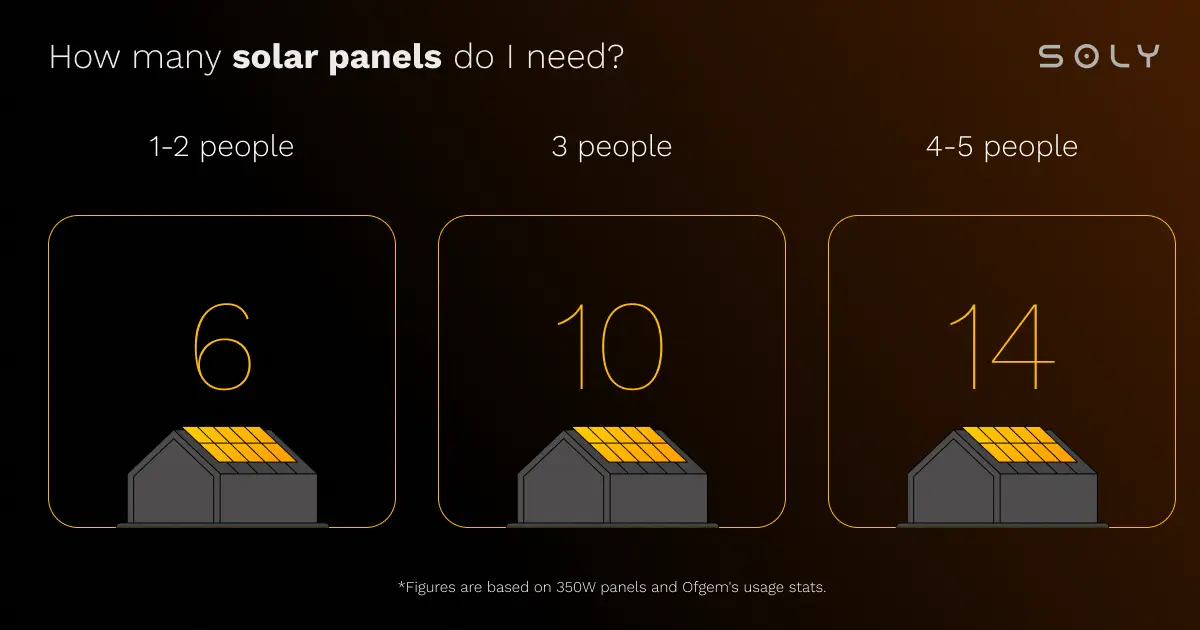
Undoubtedly, this is an important question because it determines the size of your solar panel system, the overall solar panel costs, and your potential savings.
The number of solar panels you’ll need will depend on several factors. These include things like your household’s energy consumption, just how efficient your panels are, the average sunlight your home gets and more. Make no mistake about it: the more homeowners switch over to solar power to cut down on energy bills and promote sustainability, the more it prompts us all to gain a better understanding of just how many solar panels are needed. Indeed, this is another piece of the puzzle that will help you balance your energy needs with your overall solar system investment.
On this page, you’ll discover:
- How to estimate the number of solar panels you need for your home
- Key factors that impact the size of your solar panel system
- The role of your roof space and sunlight hours in determining how many panels are necessary
- How to easily calculate the number of solar panels using our tool
Choosing the right size for your solar PV system is crucial for maximising energy production and savings. Your installer will assess the size needed based on your energy consumption, roof space, budget, and goals.
- If you want to estimate it yourself and get a rough idea, keep on reading.
- Want to skip the maths? Seek professional advice from a certified solar panel installer!
Let’s get started!
- Overview: How many solar panels do I need to power my house?
- How-To #1: Easily estimate your solar panel needs with our UK calculation formula
- How-To #2: Use our advanced solar panel configurator
- What factors affect how many solar panels you need?
- Frequently Asked Questions
- Next steps: Getting started with solar panel installation
- The bottom line
Overview: How many solar panels do I need to power my house?
The number of panels you’ll need depends largely on your household size, energy usage, and available roof space. When we take a look at some of the most common scenarios out there, we can get a better idea of how many solar panels your home may require. This will help you understand the size of your solar panel system and give you a much clearer picture of how much energy it can produce. Additionally, it will shed light on just how much roof space is needed.
Let’s take a look at typical UK households and how many solar panels they might need:
The estimates above are based on common household energy consumption levels based on Ofgem’s stats and roof space requirements in the UK. Keep in mind that actual numbers may vary. They depend on things like solar panel efficiency, location, and how much energy your home typically uses.
Here’s a simple guide:
- 1-bedroom house (1-2 people): around 6 solar panels
- 3-bedroom house (3 people): about 10 solar panels needed
- 5-bedroom house (4-5 people): typically 14 solar panels needed
It’s worth remembering that the output of your solar panel system will depend on a few important factors like the number of peak sunlight hours your geographical location receives and the efficiency of the panels. In this chart’s estimates the solar panel’s output used is 350W, which is the standard for many high efficiency panels.
Although these numbers provide a helpful guide, remember that they are general estimates. The exact number for your home’s energy requirements may differ. More on that later.
Keep reading to learn more about the other factors that influence how many solar panels you need.
Key takeaways:
Here’s a quick breakdown of what influences the number of panels you’ll need for your home:
How-To #1: Easily estimate your solar panel needs with our UK calculation formula
If you’re curious about how many solar panels you need for your home, there’s an easy way to estimate it yourself using a simple DIY formula.
Here’s how to calculate how many panels you need on your own:
DIY Formula:
Number of panels = Daily Household Energy Usage (kWh) ÷ Solar Panel Output (kW) x Average Daily UK Sunlight Hours x Performance Rate (PR)
Let’s calculate each variable one-by-one. Shall we?
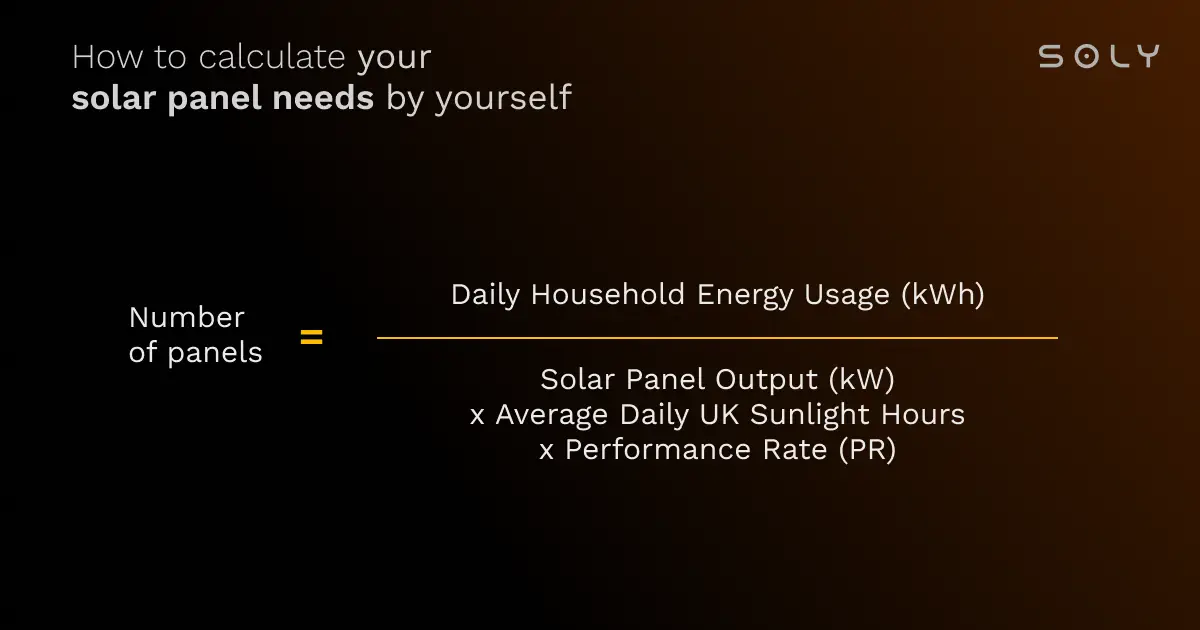
- Daily household energy use: To determine how many solar panels you need for your roof, start by reviewing your monthly energy bills. According to Ofgem’s statistics on electricity usage in the UK, a 2-3 bedroom house (2 to 3 people) consumes 2.700 kWh yearly. So, the average daily household energy usage is 7.4 kWh (Calculation: 2700 kWh÷365 days).
- Solar panel output: Solar panel output can differ between models, but generally, each panel is expected to generate between 350 and 450 watts (W) when conditions are ideal.
- Average daily sun hours in the UK (2015-2024): According to Statista, the lowest average sun hours occur in January and December. Since 2001, average daily sun hours have stayed above 4, peaking at 4.9 hours in 2003 and 2022. Government data shows an average of 4.3 sun hours per day, which is 0.6 hours less than in 2022 and 0.1 hours below the 20-year average. So, for our example here, just to be on the safe side, we will use 4 sun hours.
- Performance Rate: The average performance ratio is approximately 0.75, which takes into account shading and other factors that reduce efficiency. This is a standard metric in the solar industry that measures the efficiency of a solar power system compared to its theoretical output.
Once you’ve calculated how much energy you use and taken into account solar panel output and sunlight hours, you’ll have a better idea of just how many solar panels you need. Now you have an estimate.
But keep in mind, this is just a starting point.
The actual number of panels will depend on the factors like the size of your roof, how efficient the panels are, and what your energy goals may be.
How-To #2: Use our advanced solar panel configurator
Fortunately, if you prefer to avoid complex maths and formulas, we’ve got you covered. Our advanced solar panel configurator makes the process simple. By using this tool, you’ll get a straightforward estimate of how many solar panels you need based on your energy needs, location, and roof space.
We’ve done all the hard work so you don’t have to. Just a few quick inputs, and you’ll get an accurate recommendation tailored to your home.
Step 1: Just enter your address, and we’ll calculate your roof size and the amount of sunlight your home receives.
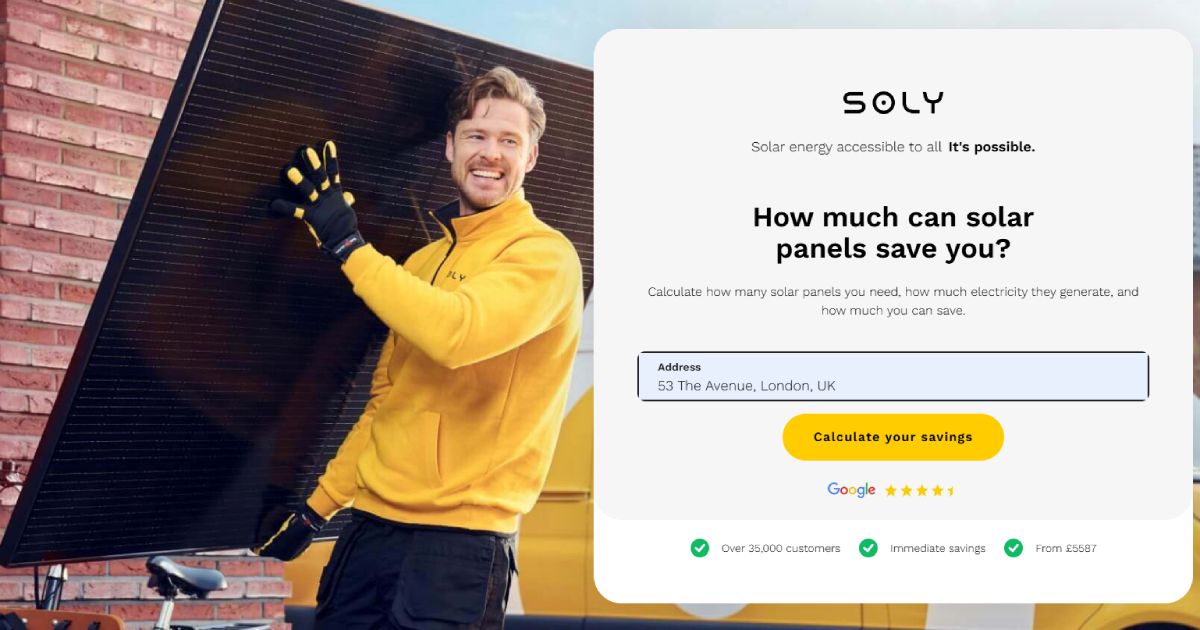
With just your address, our advanced tool calculates your roof size and estimates the sunlight your home receives over the year. This gives us everything needed to create a more personalised recommendation for your solar panel system.
- The number of panels required, based on your exact location and roof dimensions.
- The annual electricity your panels will generate.
- The potential savings on your energy bills by switching to solar.
This takes out all the guesswork, providing you with a quick, precise estimate: no complicated maths needed!
Step 2: You create your solar energy system for your home.
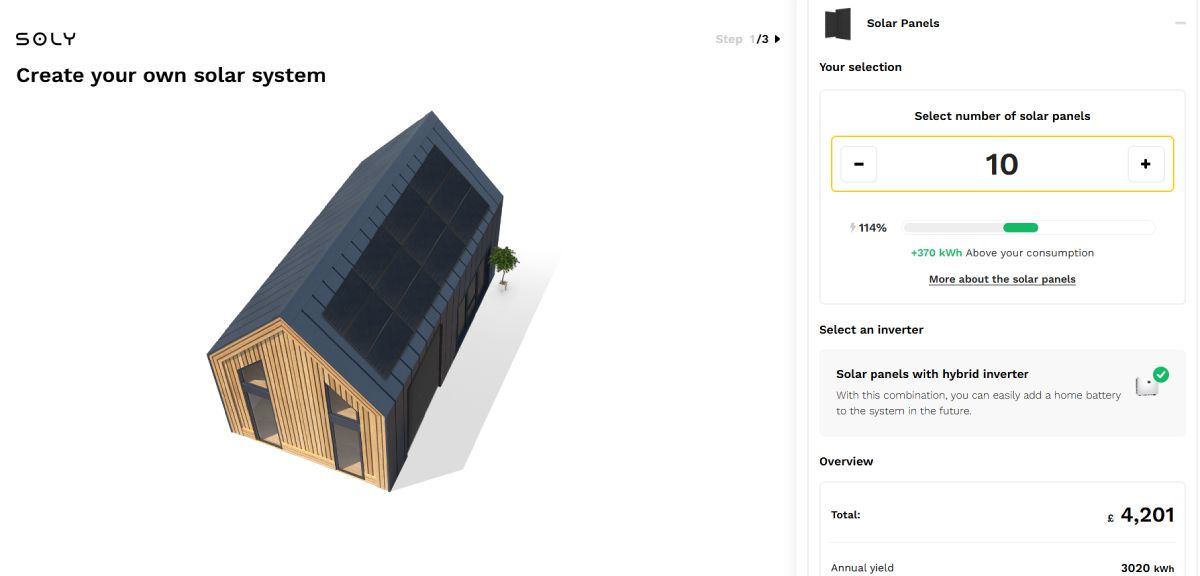
Now it’s time to fine-tune your solar energy system to perfectly match your home’s needs. Our configurator guides you through each step. This makes it easy to create a system that’s meant for your household. Here’s what you’ll enter:
- Household energy usage: Enter the number of people in your household, or if you know it, provide your exact power consumption. This allows us to accurately size your system based on your energy needs.
- Roof type: Choose between a flat or pitched roof. This helps us design the best solar setup for your specific roof structure.
- Roof material: Select what your roof is made of, whether it’s tiles, asphalt, or steel. This detail helps us determine the best installation method for your panels.
- Roof orientation: Indicate which direction your roof faces—North, South, East, or West—so we can factor in sunlight exposure.
Once this information is provided, we’ll calculate the exact number of panels that you’ll need to meet your energy requirements.
Next, you can choose additional components for your solar PV system. This could include things like a solar inverter and solar home battery. While battery storage is optional, it can enhance your energy savings in the future. Think winter conditions – a battery allows you to store excess energy from sunny winter days for those more dim and cloudy ones. You can also draw energy during off-peak hours when prices are lower, to use during on-peak, more expensive hours.
Finally, confirm your selections, and you’re ready to move on to the next step.
Step 3: Get a no-obligation proposal including est. total cost of your selection and potential savings
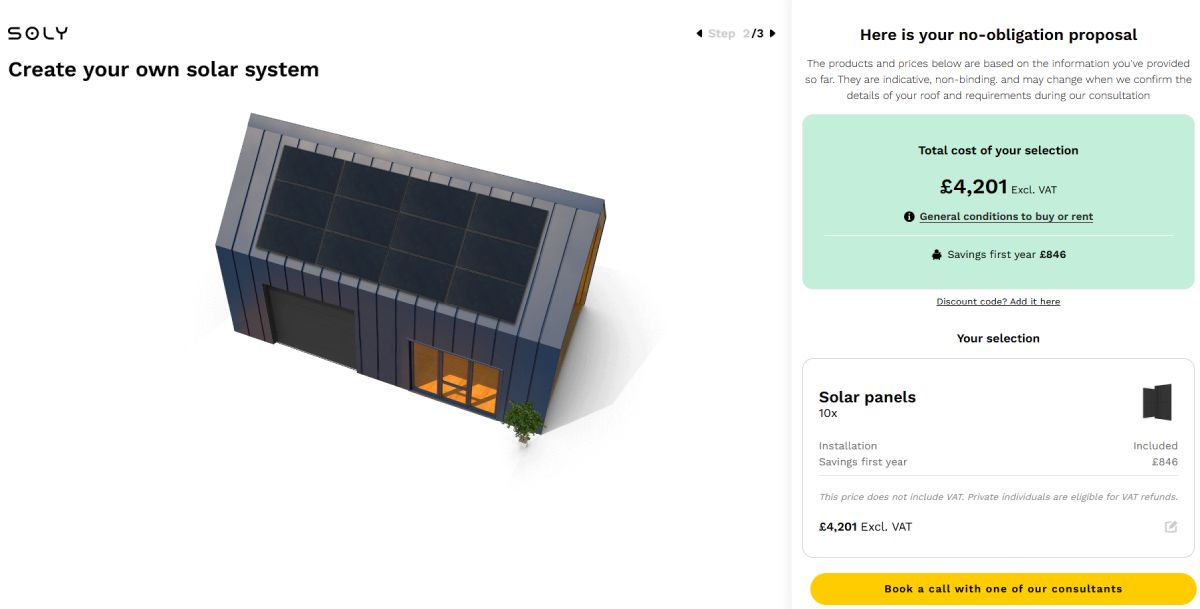
After configuring your solar panel system, you’ll receive a no-obligation proposal that clearly details everything you need to know, including:
- Total cost: A breakdown of the selected solar panels and any extras, like a solar battery or inverter.
- Estimated energy generation: An annual projection of how much electricity your system will produce, tailored specifically to your home’s energy profile.
- First-year savings: A snapshot of the amount you could save on your energy bills within the first year.
- Expected payback period: A calculation of how long it will take for your system to pay for itself through energy savings.
This proposal provides a comprehensive view of your solar investment. This lets you make a fully informed choice without any obligation at all. It’s as simple as reviewing the details and uncovering your potential savings!
What factors affect how many solar panels you need?
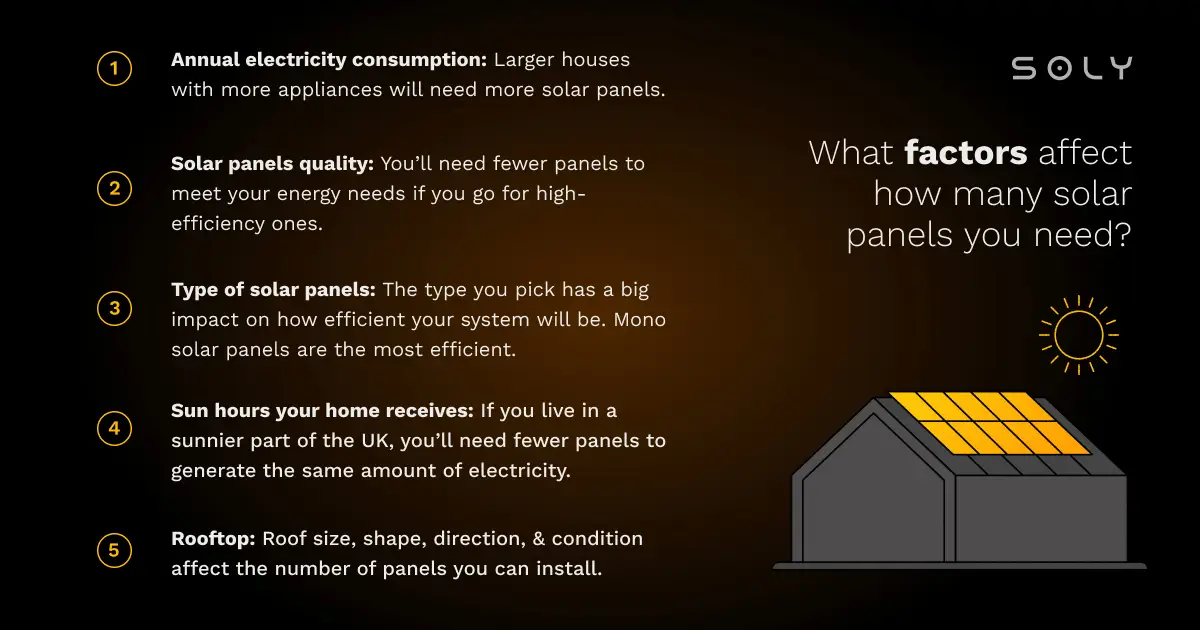
To determine how many solar panels your house needs, you have to know:
- What your annual electricity consumption is.
- What the quality of solar panels is.
- What type of solar panels you need to choose (hence efficiency).
- How many sun hours your home receives.
- How big your roof is, how many square metres are available, the direction it faces and the weight it can hold.
By understanding these key factors, you can get a clearer idea of how many solar panels you’ll need to power your home. Your accredited installer will help assess all of this, but it’s always good to know the basics before getting started! Let’s discuss these factors in detail below:
Factor #1: Annual electricity consumption
One of the main factors in figuring out how many solar panels you’ll need is your home’s yearly electricity use. This can vary a lot depending on how many people live in your home and how much energy you typically use day-to-day. Inevitably, larger households with more appliances and devices will generally need more panels to cover their energy needs than smaller households.
Here’s a quick breakdown of typical electricity consumption based on household size:
The size of your household directly influences your electricity needs and, in turn, the number of solar panels required. For example, a 1-2 person household typically uses around 1,800 kWh annually. This would mean that they should need around six panels to meet their energy needs. In contrast though, a larger household of 4-5 people might consume around 4,100 kWh per year. This would require somewhere in the region of 14 panels.
As mentioned, to estimate your annual energy use, you can use your latest electricity bill. If the bill covers:
- Two months, multiply the total kWh by 6 for an annual estimate.
- One month, multiply the total kWh by 12 for your yearly usage.
For the most accurate information, log into your energy provider’s online account. Oftentimes, this is where they usually show your exact yearly energy use in kilowatt-hours (kWh). Knowing your annual electricity consumption is a very important first step in figuring out how many solar panels you’ll need for your home.
Factor #2: Solar panels quality
The quality of your solar panels plays a big role in how efficiently they turn sunlight into electricity. While higher-quality panels might have a higher upfront cost, they generate more electricity from the same amount of sunlight compared to lower-quality options. This means you’ll need fewer panels to meet your energy needs if you go for high-efficiency ones.
Investing in these high-performance panels can also help you recoup costs more quickly. With increased energy production, you’ll save more on electricity bills, shortening the time it takes for your solar system to pay for itself.
To ensure lasting performance and durability, it’s important to choose panels from trusted manufacturers. High-quality panels are more efficient and can make a noticeable difference in your overall savings and the size of your system over time.
Factor #3: Type of solar panels and efficiency
When choosing panels, the type you pick has a big impact on how efficient your system will be.
Monocrystalline panels are the most efficient, converting over 20% of sunlight into electricity. This makes them great for homes with limited roof space. While they require a larger upfront investment, their high efficiency and durability offer strong long-term savings.
Polycrystalline panels are more affordable, with efficiency rates between 14-16%. They’re a good option for homes with more roof space. Additionally, they offer a balance between cost and performance.
Thin-film panels, while less efficient (7-15%), are lightweight and flexible. This makes them ideal for unique projects or areas where flexibility is essential.
Factor #4: Sun hours your home receives
Undoubtedly, weather conditions also play their part. When figuring out the number of solar panels you need, the amount of sunlight your home gets is really important. In the UK, the amount of sunshine can vary a lot based on where you live. On average, the UK gets about 1,403 hours of sunshine per year. However, different sun hours can range from as low as 1,100 hours in northern Scotland to over 1,700 hours in places like Dover and Plymouth in southern England.
If you live in a sunnier part of the UK, you’ll need fewer panels to generate the same amount of electricity compared to areas with less sun. Even in cloudier regions, modern high-efficiency panels can still generate a good amount of power. This is what makes solar energy a viable option across the UK. However, homes in areas with fewer sunlight hours might need a few extra panels to meet their energy needs.
Factor #5: Roof considerations
Your roof plays a big part in determining the number of solar panels you can install and how much energy they’ll produce. The size, shape, and condition of your roof all impact the number of panels you can fit. Larger roofs can hold more panels, while smaller roofs might need higher-efficiency panels to get the most power out of the space. The direction your roof faces also affects how well your system works. Of course, south-facing roofs are ideal for catching the most sunlight.
Here’s a guide to help you estimate the number of panels you can install based on your available roof space:
Available space & size
The amount of usable roof space is a key factor when installing solar panels. Roofs with features like cross-gables, chimneys, or other obstacles can reduce the available space for panels, making it important to carefully plan where panels can be placed to maximise efficiency. Here’s what to know:
- Complex roofs: Structures with multiple angles or obstacles may restrict space for solar panels.
- Accurate measurements: Refer to building plans or hire a professional for precise space calculations.
Small roofs: Consider fewer, high-efficiency panels to maximise energy production in limited space.
Direction and orientation
The direction your roof faces has a big impact on how well your solar panels perform. A south-facing roof is ideal because it gets the most sunlight throughout the day, maximising energy production. Roofs that face other directions can still work, but they might not be as efficient and could need more panels to meet your energy needs. Here’s what to keep in mind:
- Optimal direction: South-facing roofs yield the highest solar output.
- Slight efficiency loss: Southeast or southwest-facing roofs may experience a minor 1-4% drop in efficiency.
- More panels needed: East and west-facing roofs might need extra panels to achieve the same energy output.
North-facing: A comprehensive evaluation is necessary to determine if solar installation is viable for these orientations.
Weight Capacity
Making sure your roof can support the weight of solar panels is also important when it comes to a safe installation. The panels need to be securely mounted and angled properly to catch the most sunlight and work efficiently. Here’s what to remember:
- Roof strength: Make sure your roof can handle the weight of both the panels and mounting equipment.
- Inclination angle: In the UK, a 30-40 degree tilt is generally optimal for capturing the most sunlight.
- Professional help: Always speak with a solar expert and accredited installer to be sure that the roof can manage the load safely and that best installation practices are followed.
For a safe and efficient solar installation that’s tailored to your home, it’s important to work with a professional. They’ll check your roof’s size, structure, and orientation to ensure the setup works perfectly.
Remember, if you want a quick estimate, you can use Soly’s online configurator to figure out how many panels you’ll need. Plus, you can easily schedule a no-obligation chat with one of our solar experts to get personalised advice to make sure your system is just right for your energy requirements.
Frequently Asked Questions
How do I calculate how many solar panels I need?
To calculate the number of solar panels you need, start by determining your household’s annual electricity consumption in kilowatt-hours (kWh). You can find this information on your energy bills. Divide that amount by the output of a typical solar panel (around 350W-435W per panel). Then, consider your location’s average sunlight hours per day (usually between 3.5 and 4.5 hours in the UK) and apply a performance ratio of roughly 0.75 to account for efficiency losses.
For a quicker, more accurate calculation, you can use Soly’s online configurator. This incredible tool simplifies the process and provides a tailored estimate based on your home’s specifics.
How many solar panels are needed to power a typical house and go off grid?
The number of solar panels needed to power a typical house depends on household size and energy consumption. For a 1-2 person household with low consumption (1,800 kWh), you’d need around 6 panels (2 kWp). A 3-person household with medium consumption (2,700 kWh) would require 10 panels (3.5 kWp), while a 4-5 person household with high consumption (4,100 kWh) needs 14 panels (5 kWp). In all cases, pairing these systems with battery storage is essential to cover energy needs during non-sunny hours and winter months*.
*Disclaimer – To go completely off grid you would need to disconnect your meter, or you would still have a standing charge. Due to varying generation, you would need to ensure the system was big enough to cover variations across the year.
How many solar panels do I need for a 3 bedroom house in the UK?
A typical 3-bedroom house in the UK consumes around 2,700 kWh of electricity annually. Assuming you install a 3.5kWp system with each panel generating 300 kWh per year, you’d need approximately 9 panels. To account for potential inefficiencies, 10 panels would be a practical recommendation*.
*Disclaimer – This calculation provides an estimate. Generation is affected by location, orientation, pitch and shade. Please contact us directly to get a unique quote tailored to your property.
Is 5kW enough to run a house?
A 5kW solar system generally suits most medium-sized UK homes. This is because it produces around 4,250 to 5,000 kWh annually. This should be enough to cover average household energy needs. However, homes with higher energy demands might require a slightly larger setup to fully support their consumption.
How many solar panels do I need for 4,000 kWh per month?
To generate 4,000 kWh per month (48,000 kWh annually), you’d require a sizable solar array. This would be somewhere around ~100 panels, each rated at 350W. This estimate aligns with typical UK sunlight conditions (4h/day) and panel efficiency. It would create ample output for such high energy demands.
How many solar panels do I need to charge a car?
To charge an electric car using solar panels, we need to consider the car’s annual energy consumption and the solar panel output. Assuming an average electric car drives 15,000 km per year and consumes 0.2 kWh per kilometer, the car would need around 3,000 kWh annually. If each solar panel is 435W and receives about 4 hours of sunlight per day, each panel generates approximately 1.74 kWh per day. To meet the car’s yearly needs, you’d require about 8 panels (3,000 kWh ÷ (1.74 kWh/day × 365 days)). This estimate assumes average sunlight and does not account for other energy usage.
Next steps: Getting started with solar panel installation
Switching to solar energy is simpler than you might think. This is especially the case when you work with Soly. We handle every detail: from evaluating your roof to installing a custom solar PV system tailored to your energy needs. With our seasoned guidance, the journey to solar becomes smooth and worry-free.
Follow these steps to get started:
- Examine your energy used to pinpoint how much solar power you’ll need.
- Survey your roof’s size, condition, and orientation to verify it can bear solar panels.
- Consult with trusted installers like Soly for no-obligation quotes to determine the best fit for your home.
- Use Soly’s online configurator to kickstart your journey and book a consultation with one of our experts for a tailored solar solution.
The bottom line
Indubitably, switching to solar is one of the savviest financial moves you can make. By calculating the number of solar panels you’ll need, selecting top-tier panels, and ensuring your roof is ready, you’ll secure an efficient solar investment that generates savings.
Just remember that by choosing the right panels and using tools like Soly’s configurator, you’ll be poised to install a system that not only covers your energy needs but also shrinks your carbon footprint.
Why choose Soly?
At Soly, our notoriety comes from making solar energy simple. We ensure a hassle-free experience from start to finish. Here’s why we stand out:
- We are proud to have a 4.6-star rating on TrustPilot and a 4.8-star rating on Google, and to be a certified Which? Trusted Trader.
- Our installers are local, reliable, and accredited by HIES, TrustMark, and MCS, ensuring high-quality, professional installations.
- With more than 10 years in the solar industry and over 35,000 happy customers, we have the expertise to deliver top-quality solar installations.
- Our solar panels come with guarantees of up to 25 years, and our solar batteries have 15-year guarantees, giving you peace of mind.
Contact our solar experts today to see how we can help you determine all the best when it comes to your solar panel system so you can start saving on your energy bills.
*Disclaimer – Calculations shown on this page are based on estimates. Please contact us directly to get a unique quote tailored to your property.